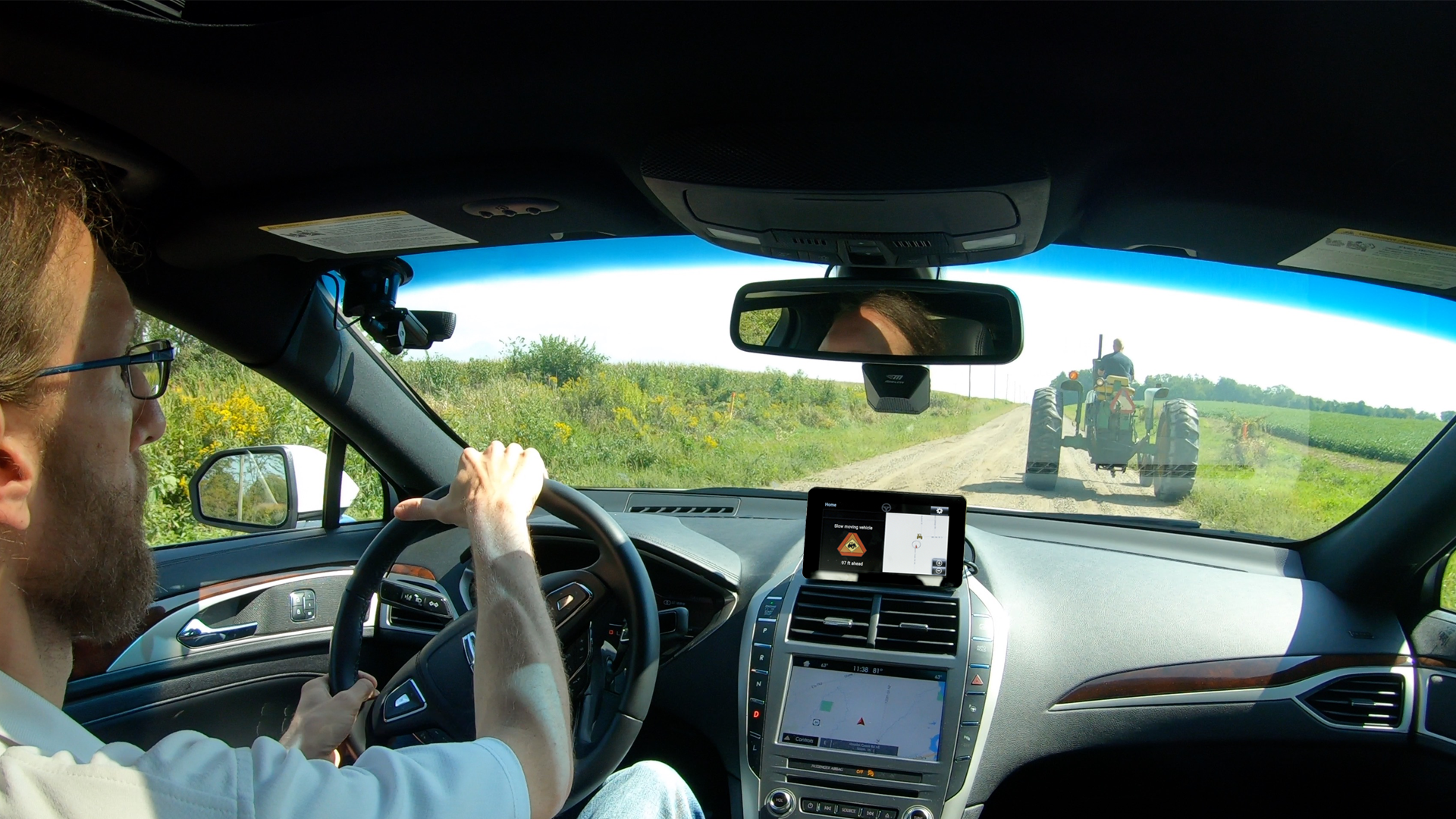Iowa researchers prepare rural roads for the future

Rural residents are few in number, but the roads on which they drive see a disproportionately high number of traffic fatalities in the United States.
Only about 19% of Americans live in places designated as rural, but about 50% of annual traffic fatalities every year happen on rural roads, says Dan McGehee, director of the University of Iowa’s National Advanced Driving Simulator (NADS) and associate professor of industrial and systems engineering in the UI College of Engineering.
Yet, most traffic safety research focuses on large urban areas, where researchers look for the best ways that cars can traverse heavily congested streets and highways. That work leaves out vast rural stretches of America, though, where roads may not be congested but pose their own challenges.
At the University of Iowa, we are proud to graduate future engineers and leaders who will meet and exceed the needs of modern industry and service organizations. The Department of Industrial and Systems Engineering aims to emphasize a broad curriculum in engineering fundamentals coupled with the chance to engage with individual interests.
So NADS is filling that void, becoming one of the nation’s leaders in the study of transportation safety and automated vehicles in rural settings. That’s especially true for self-driving vehicles and how they will fit into rural transportation.
“Studying automated vehicles in urban areas is important and necessary work, but when you consider that most of America, geographically, is rural, we can’t forget to study the impacts in those regions too,” McGehee says. “Given that Iowa is still a largely rural state, we’ve been committed to establishing ourselves as a leader in rural roadway research.”
Researchers say the disparity in road safety has numerous causes:
- Farmers drive their equipment on rural roads, and many drivers unfamiliar with farm vehicles don’t realize how slow they’re going and don’t adapt their own speed (rear-ending is the most common form of crash).
- Farm vehicles, trucks, and other large vehicles often have to swing into the opposite lane when turning from one road onto another.
- Older farm vehicles may not have adequate signage or lighting.
- Drivers may not see hidden field entrances.
McGehee says rural crashes also tend to take place at higher speeds, that the roads have sharp curves and steep grades that limit sight distances, and that rural roads are also narrower, with abbreviated shoulders. Hazards such as ditches, culverts, utility poles, and trees are closer to rural roads than to urban roads or interstates. Rural roads are also often so remote that when crashes do occur, it takes longer for emergency services to get to and from the scene than it would in an urban area, which has a dramatic impact on how soon victims reach trauma centers.
Iowa has the highest rate of farm equipment crashes on public roads of any state in the U.S.—107 per 100,000 people—so making rural transportation safer is especially important for Iowans.
“The Iowa DOT wants to know what it means to be ready for automated vehicles, and we have our finger on the pulse of this space and have the technology to do this research in a way that no other center can.”
Omar Ahmad, deputy director of NADS, says research on rural roadways will take on added importance as automated vehicles become more prevalent. Automated driving technology uses onboard sensors, cameras, radar, Light Detection and Ranging (LIDAR), and high-definition maps to navigate roads and sense other vehicles, pedestrians, and the roadway environment. But rural roads pose different challenges, especially those paved with gravel, as they often lack the curbs and lane markings that onboard sensors use to guide the vehicle.
Although McGehee thinks widespread use of automated vehicles is still decades away, transportation planners today still need to consider the best way to establish an infrastructure that will accommodate them. NADS has been receiving outside funding from the auto industry and state and federal governments that will help researchers prepare for that day.
“Our research generally operates about 20 years ahead,” McGehee says.
A $490,000 contract with the Iowa Department of Transportation (Iowa DOT) is helping UI researchers enhance a NADS-developed vehicle that alerts drivers to the presence of stopped school buses and slow-moving tractors that could pose hazards.
“The Iowa DOT wants to know what it means to be ready for automated vehicles, and we have our finger on the pulse of this space and have the technology to do this research in a way that no other center can,” Ahmad says.
The test vehicles are equipped with cellular technology that tracks each vehicle’s location and relays that information to the driver through a cloud-based map presented on the dashboard. Some of the NADS research vehicles simulate school buses and tractors, and as they near each other, an automated signal warns drivers of an approaching vehicle. The technology is so precise, it can even tell the driver when a school bus stop sign arm is extended and children may be crossing the roadway.
The researchers have been using these specially equipped vehicles on rural roads in Johnson County.
Building on its rural driving-safety expertise, NADS also recently received a $7 million grant from the U.S. Department of Transportation that will be used to focus on how automated vehicles operate on rural roads and how they can be used to help elderly, disabled, and other rural residents with mobility issues. The on-road demonstration will provide more data and information that can help identify challenges, opportunities, and insights relevant to operating automated vehicles safely on rural roads.
“Our Automated Driving Systems for Rural America project will help to demonstrate the safe integration of automated vehicles on our nation’s rural roadways, particularly how they can benefit America’s rapidly growing senior population,” says McGehee. “It’s another example of our commitment to be leaders in automated vehicle safety research.”
Although fully functional automated vehicles are still far in the future, Stephen Cable, a systems administrator at NADS working on the project, says one immediate benefit of the research is that much of the technology can help drivers operate their vehicles more safely today on both rural and urban roads.
“There’s going to be a need for a human driver for a long time, and automation can help people be better drivers,” Cable says.


